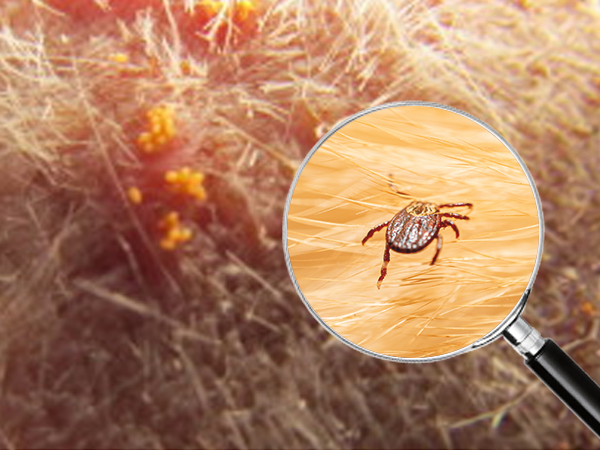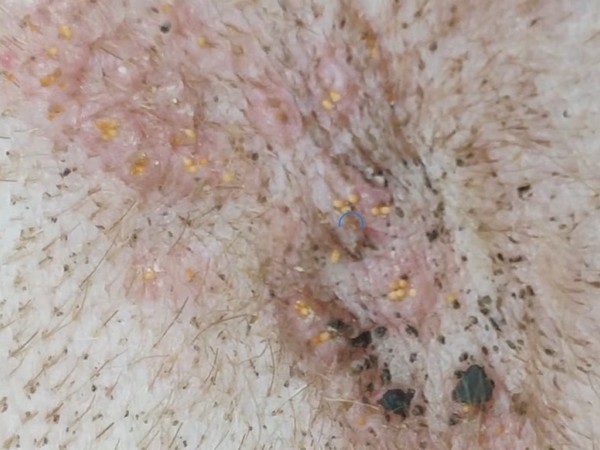Harvest mites on dogs
If your dog's been scratching more than usual, especially after a walk in a grassy or wooded area between July and November, harvest mites may be the culprit.
These tiny, bright orange or red mite larvae are particularly active from late summer until the first frosts of winter and can cause real discomfort. Keeping your dog out of areas with dense vegetation during peak mite season and regularly checking them for signs of mites can help reduce the risk. If you suspect harvest mites have bitten your dog, seek advice from your vet, who can recommend treatments to kill the mites, soothe the itching and prevent further irritation.
What are harvest mites?
Harvest mites are a relative of spiders that thrive in dense vegetation. As adult mites, they feed on vegetation and don’t cause any problems to humans or animals. However, the mite larvae develop and grow by taking meals from passing animals. They wait for a warm-blooded host to pass by, latch on, and then crawl to areas where the skin is thinner — such as the ears, tummy, or between the toes — and begin to feed.
These mites don’t just bite — they use their fang-like mouthparts to cut into the skin and inject an enzyme-filled fluid that dissolves cells, turning them into a liquid that the mites then suck up. This process can cause intense itching and inflammation. After feeding for two to three days, the mites drop off to continue their development, leaving behind irritated skin that may take time to heal.
Harvest mites are most commonly found in areas with:
- Long grass
- Woodland
- Chalky soils
Is my dog at risk from harvest mites?
All dogs can get harvest mites, but those with longer fur might be more susceptible, as they provide harvest mites with the perfect hiding spot. If your dog has sensitive skin, they might find harvest mites particularly troublesome. These mites can also affect cats, rabbits, and even humans.
Pictures of harvest mites on dogs


How do I know if my dog has harvest mites?
Keep an eye out for these signs:
- Tiny red or orange dots, often found between the toes, on the legs, in the armpits, around the ears, or on the tummy. The mites tend to attach just in front of the ears, at the base of the ear flap, or between the toes. Less frequently, the chin, lips, armpits, and tummy can also be affected.
- Intense itching, leading to excessive scratching, licking, and biting at the infested areas
- Red, inflamed skin, often with crusting as a result of scratching or licking
- Yellow scabs and, in severe cases, pus
- Stained fur from all the licking and biting
How to get rid of harvest mites on dogs?
Treatment may involve:
- Medications to kill the mites
- Anti-inflammatories or steroids to relieve itching, inflammation and discomfort
- Antibiotics if there’s a secondary infection
Some flea treatments have shown effectiveness against harvest mites. A spray containing the insecticide fipronil can be applied to susceptible areas every two weeks during the harvest mite season (late July to early October) if your dog is particularly sensitive.
One study (see summary below) found that a permethrin-fipronil spot-on solution was highly effective in reducing mite populations and easing symptoms over a few weeks.
Can harvest mites cause serious health issues?
Harvest mites usually cause mild discomfort only, but if left untreated, they can lead to some unpleasant complications such as:
- Raw, infected sores on the skin
- Risk of secondary infections
- In severe cases, self-mutilation or hair loss
- Rarely, neurological signs have been observed in dogs with heavy infestations (but don’t panic, this is extremely uncommon)

What’s the long-term outlook?
Most dogs bounce back quickly from a harvest mite infestation with proper treatment. The itching usually subsides within a few weeks. Just remember, harvest mites are seasonal visitors. So, if your dog enjoys going for walks in high-risk areas during the day, you’ll need to be on guard every peak season when the weather warms up. Very sensitive animals may need to be kept confined during the worst months, particularly on bright, sunny days during late morning and afternoon when the mites are at their most active.
How can I prevent harvest mites in the future?
Prevention is always better than cure. Here are some tips to keep harvest mites at bay:
- Avoid mite hotspots during peak season and peak times (middle of the day between July to October)
- Use regular flea treatments (ask your vet for a product that works on mites too)
- Check your dog after walks (especially the ears, paws, and legs)
- Give your dog’s ears, paws, and legs a good clean after walks
- Keep your grass short and borders weed-free to reduce the chance of picking up mites
Frequently asked questions
| Question | Answer |
|---|---|
| Can humans get harvest mites from dogs? | Harvest mites can bite humans but don’t typically transfer from dogs to humans. However, you might pick them up from the same place your dog did. |
| How long does it take for harvest mites to go away? | With proper treatment, symptoms usually improve within a few days to a couple of weeks. |
| Are some dog breeds more susceptible to harvest mites? | While all dogs can get harvest mites, those with longer fur or who spend more time outdoors might be at higher risk. |
Academic studies into harvest mites on dogs
Study 1: Effectiveness of spot-on flea treatments
This study looked at whether spot-on flea treatments containing permethrin and fipronil could help dogs affected by harvest mites. Over 28 days, the researchers found that dogs given the treatment showed major improvements in mite infestation, skin lesions, and itching. By day 14, nine out of 10 dogs were mite-free, which lasted until the study's end. The treatment was applied twice (on day 0 and day 14) and didn't cause any side effects.
Takeaway: A permethrin-fipronil spot-on treatment every two weeks can be a safe and effective way to control harvest mite infestations in dogs.
Study 2: Severe illness caused by harvest mites in Spain
This study examined hunting dogs that developed severe illness after exposure to harvest mites in a Spanish natural park. The mites, identified as Neotrombicula inopinata rather than the more common Neotrombicula autumalis, caused sudden vomiting, weakness, and lethargy. Unlike typical harvest mite infestations, these mites didn't cause dermatitis. The researchers suggested a potential link between these cases and seasonal canine illness (SCI).
Takeaway: Neotrombicula inopinata can cause severe illness in dogs without skin symptoms, possibly explaining some cases of seasonal canine illness. Further research on this issue is required.
Need more advice on harvest mites on dogs?
Regular checks after walks, especially during peak season, and using preventive treatments can help keep your dog comfortable and mite-free. For expert advice, visit our find a vet page to locate your nearest vet, or speak to a vet online using our video vet service.
Prevention is always better than cure, so start protecting your dog today. Members of Pet Health Club get 10% off flea and tick treatments, which can also help manage mites.


